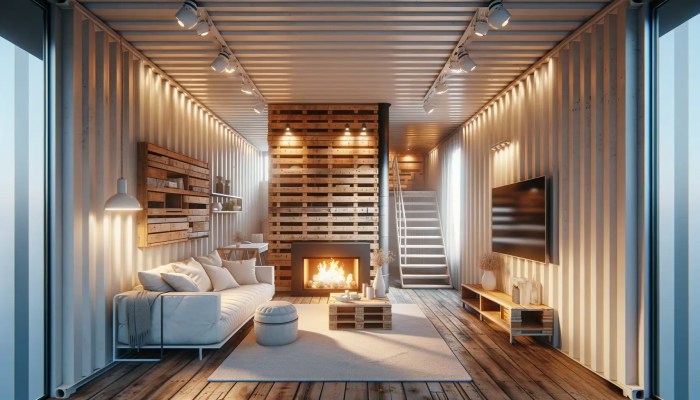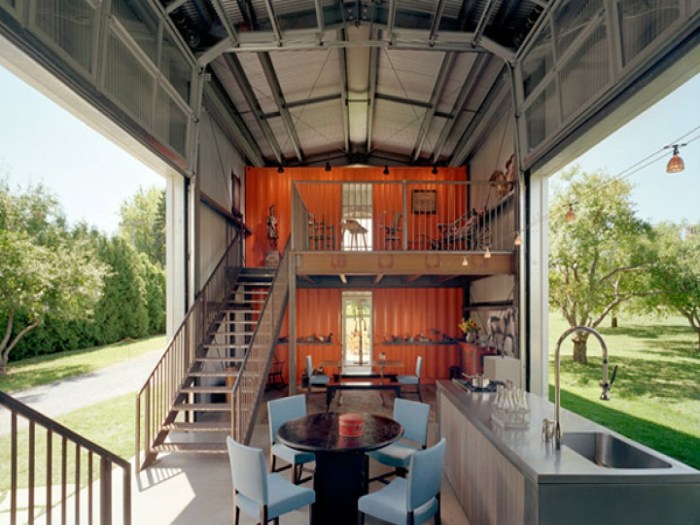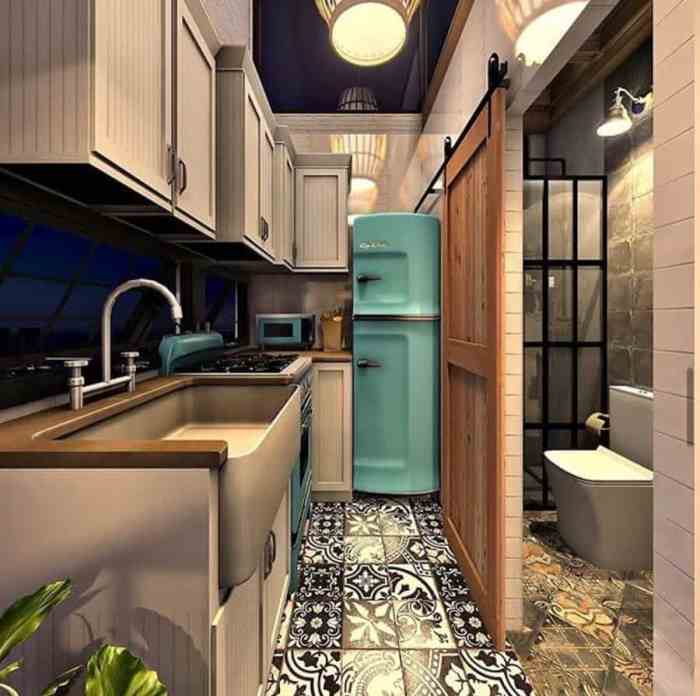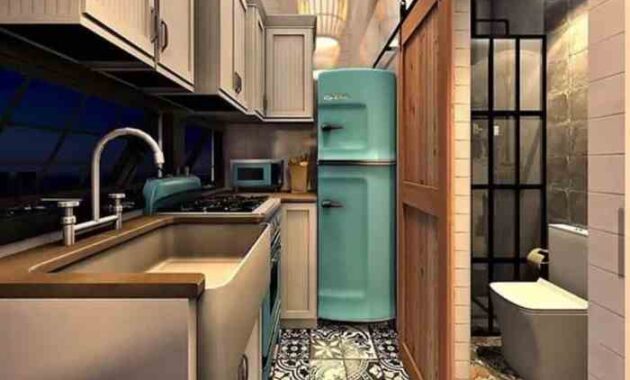Container house interior design is a unique and innovative approach to home design, utilizing repurposed shipping containers to create stylish and functional living spaces. This concept has gained popularity in recent years, offering an eco-friendly and affordable alternative to traditional home construction.
Container homes offer a range of advantages, including cost-effectiveness, sustainability, and adaptability. They can be customized to fit various needs and aesthetics, making them an attractive option for individuals and families seeking a modern and sustainable living experience.
Kitchen Design
Designing a kitchen in a container home presents unique challenges and opportunities. The limited space requires creative solutions to ensure both functionality and style. With careful planning, you can create a kitchen that is both efficient and aesthetically pleasing.
Container house interior design offers a unique challenge, as you’re working with a limited space. One way to create a sense of spaciousness is to embrace a light and airy aesthetic, similar to what you might find in a beach house living room interior design.
Think natural textures like wood and rattan, and a color palette that draws inspiration from the ocean and sand. By bringing the outdoors in, you can create a feeling of expansiveness even within the confines of a container home.
Space-Saving Kitchen Appliances and Storage Solutions, Container house interior design
Space-saving appliances and storage solutions are essential for maximizing functionality in a container home kitchen. These solutions help to create a more organized and efficient space.
- Compact Appliances:Choose compact appliances such as a mini-refrigerator, a countertop oven, or a combination microwave/convection oven. These appliances take up less space while still providing the necessary functionality.
- Multi-Functional Appliances:Invest in multi-functional appliances that serve multiple purposes, such as a blender that also functions as a food processor or a slow cooker that can also be used as a rice cooker.
- Vertical Storage:Maximize vertical space by using tall cabinets, shelves, and storage solutions that reach up to the ceiling. This helps to keep items off the counter and creates a more organized look.
- Pull-Out Drawers:Utilize pull-out drawers for easy access to pots, pans, and other kitchen essentials. This eliminates the need to reach into deep cabinets, making it easier to find what you need.
- Under-Sink Storage:Optimize space under the sink by using organizers and trays to store cleaning supplies, dish towels, and other items.
Visual Representation of a Container Home Kitchen
The following table provides a visual representation of a container home kitchen, showcasing how space-saving appliances and storage solutions can be incorporated to create a functional and stylish design:
| Column 1 | Column 2 | Column 3 | Column 4 |
|---|---|---|---|
| Compact Refrigerator | Countertop Oven | Open Shelving | Wall-Mounted Storage |
 |
 |
 |
 |
| Pull-Out Drawers | Multi-Functional Appliance | Under-Sink Storage | Hanging Pots and Pans |
 |
 |
 |
 |
Bathroom Design

Designing a bathroom in a container home presents unique challenges due to limited space. However, with clever planning and creative design choices, you can create a functional and stylish bathroom that maximizes comfort.
Compact and Comfortable Bathroom Design
Creating a compact and comfortable bathroom in a container home requires careful consideration of space utilization and functionality. Here are some tips:
- Maximize Vertical Space:Utilize wall-mounted vanities, floating shelves, and tall cabinets to maximize vertical space and minimize floor clutter.
- Choose Multifunctional Fixtures:Opt for showerheads with multiple spray settings, and consider a combination shower/tub to save space.
- Embrace Minimalism:Opt for a minimalist design approach, minimizing unnecessary accessories and furniture to create a sense of spaciousness.
- Use Mirrors Strategically:Mirrors can visually enlarge a space, so strategically place them to reflect light and create a sense of depth.
Materials and Finishes
The choice of materials and finishes plays a crucial role in creating a stylish and functional bathroom in a container home.
- Waterproof Materials:Opt for waterproof materials like ceramic tiles, porcelain, and vinyl for floors and walls to prevent water damage.
- Durable Surfaces:Select durable and easy-to-clean surfaces for countertops and vanities, such as quartz, granite, or solid surface materials.
- Lighting:Natural light is ideal, but in limited spaces, consider using LED lighting for energy efficiency and a modern look.
- Color Palette:Opt for light and airy colors to create a sense of spaciousness. A neutral color palette can be enhanced with accent colors for visual interest.
Bathroom Layout
Here’s a sample bathroom layout for a container home:
| Area | Dimensions | Description | Image |
|---|---|---|---|
| Shower | 3 ft x 3 ft | Walk-in shower with a glass enclosure, a rain showerhead, and a handheld showerhead. | [Image of a walk-in shower with glass enclosure and rain showerhead] |
| Toilet | 2 ft x 3 ft | Wall-mounted toilet to save floor space. | [Image of a wall-mounted toilet] |
| Vanity | 3 ft x 2 ft | Floating vanity with a vessel sink and storage space below. | [Image of a floating vanity with a vessel sink and storage space] |
| Storage | 2 ft x 1 ft | Wall-mounted shelves or a small cabinet for towels and toiletries. | [Image of wall-mounted shelves or a small cabinet] |
Sustainable Design Considerations

Container homes are increasingly popular due to their affordability, speed of construction, and unique aesthetic appeal. However, their sustainability is a key factor to consider when designing and building these homes. By incorporating sustainable design principles, container homes can become environmentally responsible and energy-efficient living spaces.
Sustainable Materials and Building Practices
Sustainable materials are crucial for minimizing the environmental impact of container homes. The use of recycled and reclaimed materials is a significant step towards reducing waste and promoting resource conservation.
- Recycled Steel:The primary material of shipping containers is steel, which can be recycled multiple times without losing its structural integrity. Utilizing recycled steel for container home construction reduces the demand for virgin materials and lowers the overall carbon footprint.
- Reclaimed Wood:Integrating reclaimed wood from salvaged buildings or sustainably harvested sources adds character and warmth to the interior while promoting responsible forestry practices.
- Bamboo:As a rapidly renewable resource, bamboo can be used for flooring, furniture, and other interior elements. Its strength, durability, and aesthetic appeal make it a sustainable and eco-friendly alternative to traditional materials.
- Cork:This natural material is an excellent insulator and sound absorber, making it suitable for flooring, wall coverings, and even countertops. Cork is sustainable, renewable, and biodegradable, offering a green alternative to synthetic materials.
Energy-Efficient Features and Appliances
Energy efficiency is a crucial aspect of sustainable container home design. By incorporating energy-saving features and appliances, residents can reduce their energy consumption and minimize their environmental impact.
- High-Performance Insulation:Proper insulation is essential for regulating temperature and reducing energy loss. Using materials like spray foam, fiberglass, or cellulose insulation in walls, ceilings, and floors can significantly improve the energy efficiency of a container home.
- Energy-Efficient Windows and Doors:Double- or triple-paned windows with low-e coatings and energy-efficient doors can reduce heat gain and loss, minimizing the need for heating and cooling systems.
- Solar Panels:Installing solar panels on the roof or facade of a container home can generate clean energy, reducing reliance on fossil fuels and lowering energy bills.
- Energy-Efficient Appliances:Choosing appliances with Energy Star ratings ensures they operate at optimal efficiency, reducing energy consumption and saving money on utility bills.
Examples of Sustainable Container Homes
Numerous container homes around the world showcase sustainable design principles, demonstrating the feasibility and benefits of eco-friendly living in these innovative spaces.
- The Container House, New Zealand:This home, built entirely from recycled shipping containers, features a green roof, solar panels, and a rainwater harvesting system, highlighting the potential for sustainable living in a container home.
- The Eco-Container Home, United States:This container home incorporates a variety of sustainable features, including recycled materials, energy-efficient appliances, and a green roof. The home generates its own electricity using solar panels and relies on a rainwater harvesting system for water needs.
- The Sustainable Container Home, Australia:This home, built using repurposed shipping containers, showcases a range of sustainable design principles, including passive solar design, rainwater harvesting, and a greywater recycling system.
Inspiration and Resources

Finding inspiration for your container home interior design can be both exciting and challenging. You’ll be working within a unique space, but there are many ways to make it feel spacious, stylish, and comfortable. Here are some sources of inspiration and resources that can help you create your dream container home interior.
Examples of Container Home Interiors
Examples of container home interiors demonstrate the versatility of this design approach.
- Modern Minimalist:This style embraces clean lines, neutral colors, and a focus on functionality. A container home in Australia, for instance, showcases a minimalist design with large windows that flood the space with natural light. The interior features a sleek kitchen with stainless steel appliances, open shelving, and a minimalist dining area.
Container house interior design is all about maximizing space and creating a comfortable and stylish living environment. Since container homes are often smaller in size, you can learn a lot from the principles of best interior design for small house to create a functional and visually appealing space.
The key is to use clever storage solutions, choose a light and airy color palette, and incorporate multi-functional furniture, just like you would in any small home.
- Industrial Chic:This style combines exposed elements, such as brick walls, metal accents, and reclaimed wood, with modern furniture and fixtures. A container home in New York City, for example, features exposed metal beams, concrete floors, and vintage industrial lighting. The kitchen features reclaimed wood countertops and open shelving.
- Rustic Farmhouse:This style evokes warmth and comfort, often incorporating natural materials, such as wood, stone, and textiles. A container home in Texas features reclaimed wood walls, exposed beams, and a farmhouse-style kitchen with a large farmhouse sink and butcher block countertops.
- Tropical Retreat:This style brings the outdoors in, featuring light colors, natural textures, and a focus on relaxation. A container home in Hawaii, for example, features bamboo walls, rattan furniture, and a spacious outdoor living area. The kitchen features a large island with a built-in bar.
Resources for Container Home Design Inspiration
Several resources can help you find container home design inspiration.
Container house interior design offers a unique challenge, as the space is often limited and the structure itself is unconventional. However, with a bit of creativity, it’s possible to transform a shipping container into a stylish and functional living space.
When it comes to designing the interior, it’s important to consider the principles of architecture design house interior , such as maximizing natural light, creating a sense of flow, and using space efficiently. By applying these principles, you can create a container home that is both comfortable and visually appealing.
- Websites:Websites like Pinterest, Houzz, and Dwell offer a vast library of container home interior design ideas. You can search by style, location, and budget to find inspiration that fits your needs.
- Books:Books like “The Container Home Handbook” by Philip Jodidio and “The Shipping Container Home: Design and Build Your Dream Home” by Ben C. Kelly provide comprehensive guides to container home design and construction.
- Magazines:Magazines like Dwell, Architectural Digest, and Dezeen feature articles and photographs of container homes around the world, showcasing various design styles and innovative solutions.
Container Home Architects and Designers
Several architects and designers specialize in container home design.
- Adam Kalkin:Adam Kalkin is a renowned architect known for his innovative container home designs. His work has been featured in numerous publications, including The New York Times and Architectural Digest.
- Patrick Partouche:Patrick Partouche is a French architect who has designed several award-winning container homes. His work is characterized by its use of sustainable materials and innovative design solutions.
- James Whitaker:James Whitaker is a British architect who has designed several container homes in the United Kingdom. His work is known for its focus on energy efficiency and sustainable design.
Summary: Container House Interior Design
From space planning and layout to furniture selection and sustainable design considerations, container house interior design presents a wealth of possibilities for creating beautiful and functional homes. By embracing the unique challenges and opportunities of this innovative approach, you can unlock the potential of container homes to transform your living experience.
Question Bank
What are the typical costs associated with building a container home?
The cost of building a container home can vary depending on factors such as size, location, materials, and customization. However, container homes are generally more affordable than traditional homes due to the lower cost of materials and construction.
How do I find a qualified architect or designer for a container home project?
There are many architects and designers specializing in container home design. You can search online directories, attend industry events, or seek recommendations from other container home owners.
Are container homes durable and safe?
Shipping containers are designed to withstand harsh conditions and are extremely durable. When properly engineered and constructed, container homes can be just as safe and secure as traditional homes.

